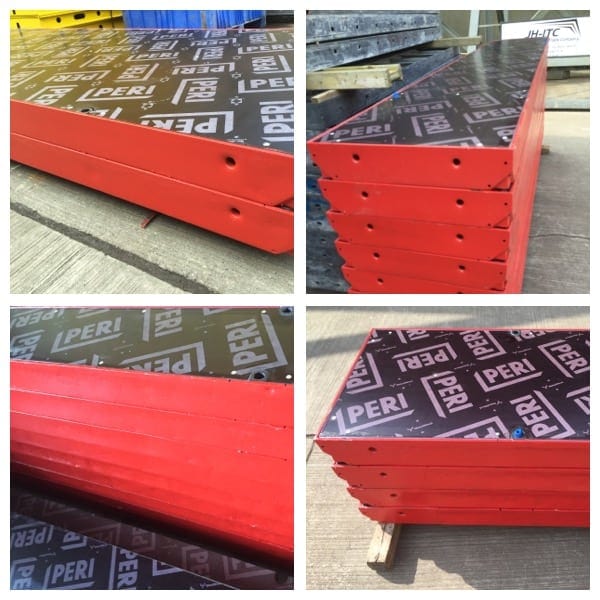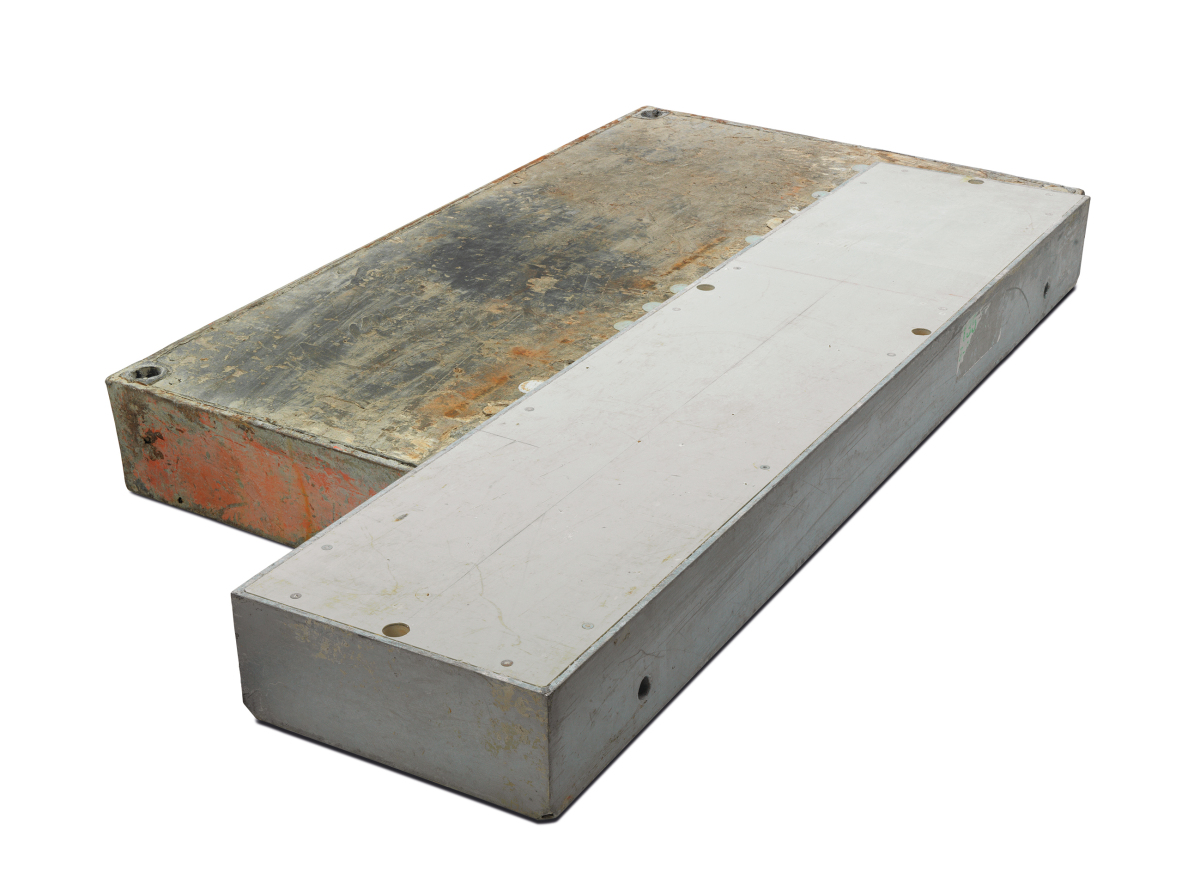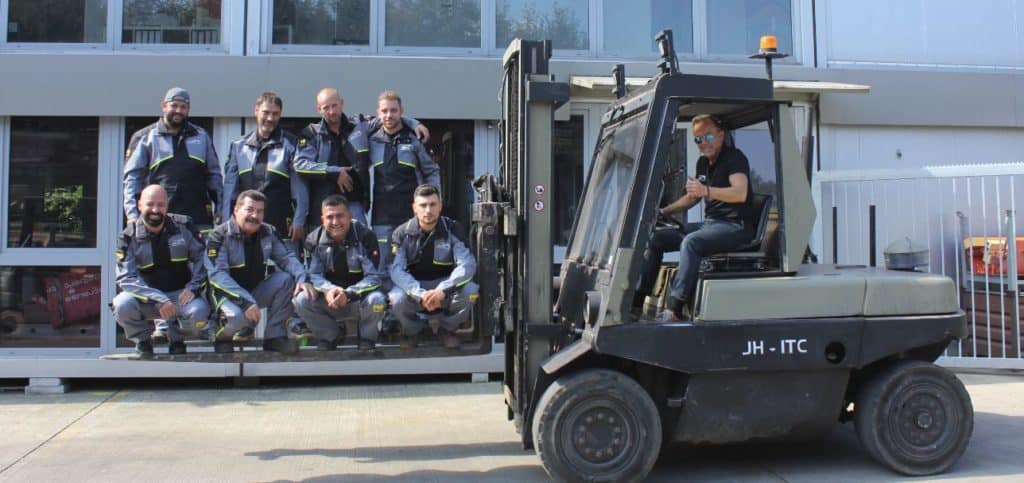Your formwork needs a repair or new formlining ?
We are happy to cover your formwork according to your wishes and requirements either with a new wooden formwork facing or, even better, with a new alkus all-plastic formwork facing.
New wood formwork skin or alkus solid plastic formwork skin

We are also happy to renovate your wall or ceiling – formwork system.

Formwork refurbishment
Renovating formwork offers better concreting results
If you are building a house and need liquid concrete for it, you also use formwork for the walls and ceilings of the house.
Since the necessary components sooner or later show damage and deformation, they must then be rehabilitated. Sometimes, however, it is sufficient to simply have a scarf skin changed.
It is also necessary to have the formwork cleaned from time to time.
What are formworks and why do you need them?
Shutterings are hollow forms used in construction. They are needed in reinforced concrete construction for the erection of walls and ceilings.
The construction moulds are filled with liquid concrete, which they then give its final shape and surface structure. Once the building material has hardened, the formwork is usually removed.
Formwork is a system consisting of various interconnected parts. The outer layer is called the formwork skin or formwork panel.
It is attached to the frame.
The type and function of the building to be constructed determine the choice of formwork ultimately used. Depending on how the concrete surface is to look later, the builder can choose between different formwork skins:
If the concrete wall is to have a natural-looking wooden structure, he uses wooden formwork or systems with inserted wooden formwork panels during construction. Unfinished formwork boards give the concrete wall a rustic look and a rough surface.
Plastic scarf skins provide smooth walls and a modern look.
Formwork systems consist of
– formwork shell
– bracing construction
– supporting construction
– accessories such as struts, spacers etc. and – connecting parts (screws, nails, tension chains etc.)
When purchasing concrete moulds, the builder can choose between systems made of steel, plastic, wood and aluminium. Depending on what is to be shuttered, the construction hollow forms have different dimensions.
As a rule, the heavy formwork is transported to the construction site with a loading crane and later dismantled and transported away after the concrete poured has hardened, unless it is “lost formwork”.
They simply remain attached to the concrete structure. The reason: they are to form boundary walls, for example. Builders who do not want (or need) to have their formwork systems custom-made can rent them from special suppliers.
Why is wall and slab formwork refurbishment necessary?
Since the concrete casting moulds have to withstand a high pressure when the concrete is poured, it can happen after several uses that they no longer meet the structural requirements. They are then no longer tight, dimensionally accurate or sufficiently secure.
Formwork systems also need to be cleaned from time to time, as dirt and concrete residues accumulate on their surface and in holes required for certain parts. Hollow forms made of plastic, glass fibre reinforced polyester and steel are generally more durable than wooden formwork and can therefore be used several times before you need to have wall and slab formwork refurbished.
In order to avoid premature wear of the formwork systems and to achieve permanently good concreting results, it is advisable to have the concrete casting moulds professionally refurbished and cleaned in good time.
Have formwork refurbished
If you want to have your formwork refurbished, many suppliers offer you the choice between a comprehensive and a less comprehensive wall and ceiling formwork refurbishment. As a rule, the specialist companies process all common formwork systems.
Which service package should be used depends on the condition of the formwork system.
Warped frames are no longer safe to operate and must be straightened.
Loose formwork parts are welded on. Clogged functional holes are cleaned with a shot-blaster.
If the formwork facing is so damaged that it shows an excessive number of chipped areas, holes and clear signs of abrasion, a formwork facing change is usually carried out.
In the case of a small formwork refurbishment, a basic cleaning is carried out first and the old damaged formwork panel is replaced with a new one.
Anchor points receive new inserts.
Finally, the formwork is then sealed. In the case of severe wear and major deformations, major formwork rehabilitation is the method of choice. Even minor damage to the frame and slight deformations already impair the functionality of the formwork system:
For example, it can then no longer be conclusively topped up.
During the major wall and ceiling formwork refurbishment, all corroded areas and old coatings are removed using the shot-blasting method.
Straightening of the frame as well as fastening and formwork welding are also part of the more comprehensive service package. The work reconnects loose parts to the formwork system and ensures that it is once again functional and safe.
Of course, the steel frame is also inspected, cleaned, sandblasted and painted or receives a powder coating.
Subsequently, new scarf skins are inserted.
Systems made of aluminium or galvanised steel are generally not treated with the shot-blasting unit.
In the case of thin-walled formwork, the builder should plan for a higher remediation effort.
Those who are experts in the field can, of course, perform the formwork welding and other work associated with the repair of the system itself:
Some specialist companies already offer ready-made and precisely cut replacement panels for this purpose.
Scarf skin change
If it is no longer possible to repair the formwork sheet, for example by inserting 40 mm or 60 mm repair plates, because their holes are too large or there are too many of them, it is necessary to change the formwork sheet.
As a rule of thumb, the panel should be replaced whenever it has more than 8 holes per square meter of surface area.
The exchange includes the following steps:
– Removal of the damaged plate
– Cleaning of the frame at the formwork shell support
– Precise cutting to size and edge sealing of the new panel
– Fixing the formwork panel with rivets or screws
– Grouting of the edges with transparent silicone
What happens during formwork cleaning?
The formwork skin is cleaned with special brushes and in a dry cleaning process. Then polish them. For thorough cleaning of the frame and the inner transoms, a high-pressure cleaner (wet method) is used. It operates at pressures of 500 to 1000 bar, depending on how dirty the parts in contact with the concrete are. Solid plastic panels can be completely refurbished without showing on their surface:
The existing holes and cracks are simply welded with liquefied plastic (PP) and the entire surface is then stripped.
What are the advantages of refurbishing the formwork system?
– You achieve a better work result
– You achieve a more uniform concrete appearance
– You only have to rework the concrete walls a little
– You save valuable time when shuttering and striking
– You need less formwork oil
– You have less cleaning effort
– You can use your formwork longer
– You protect your investment



